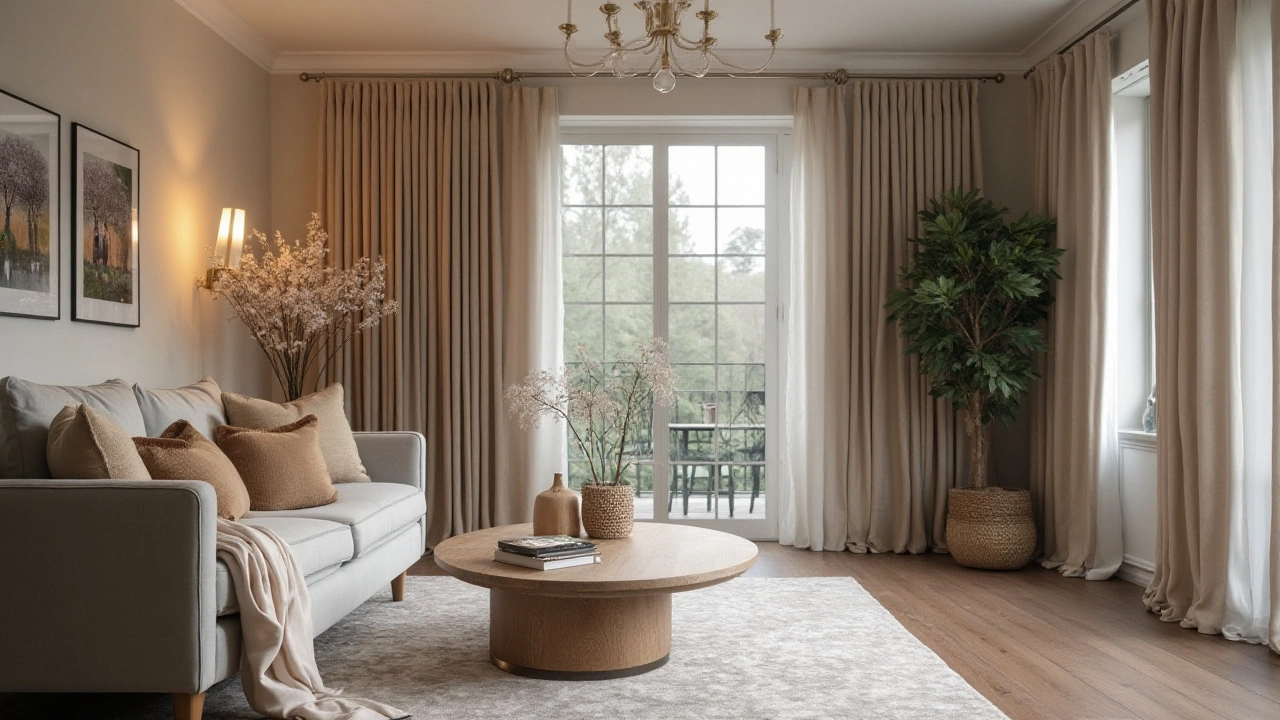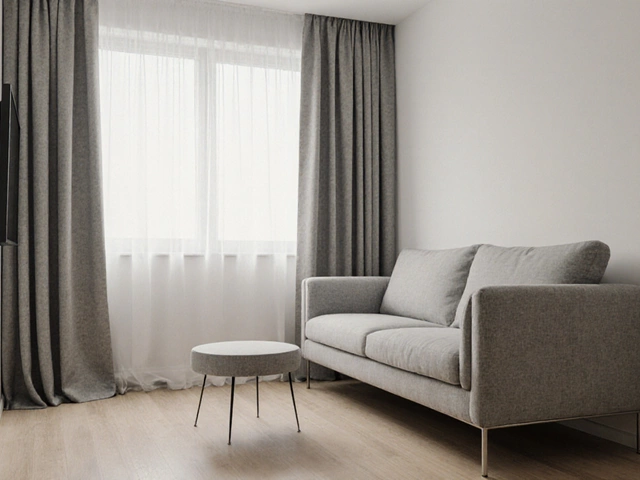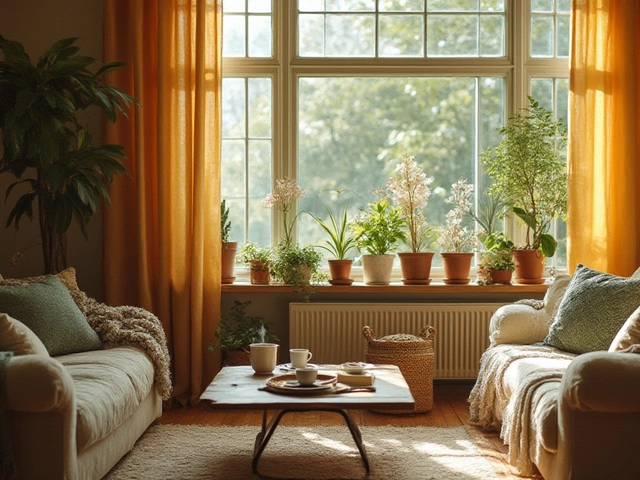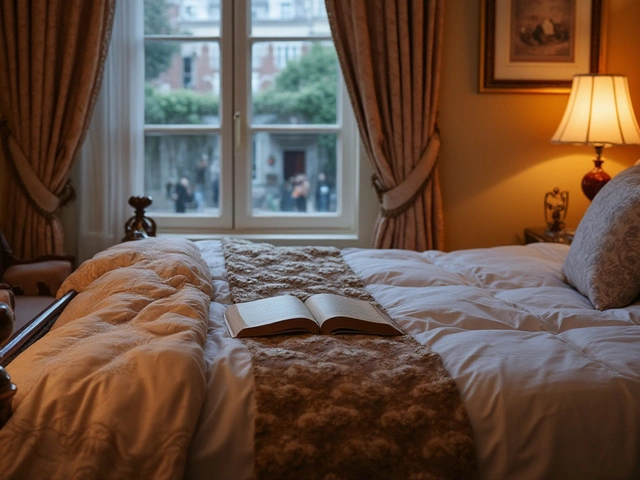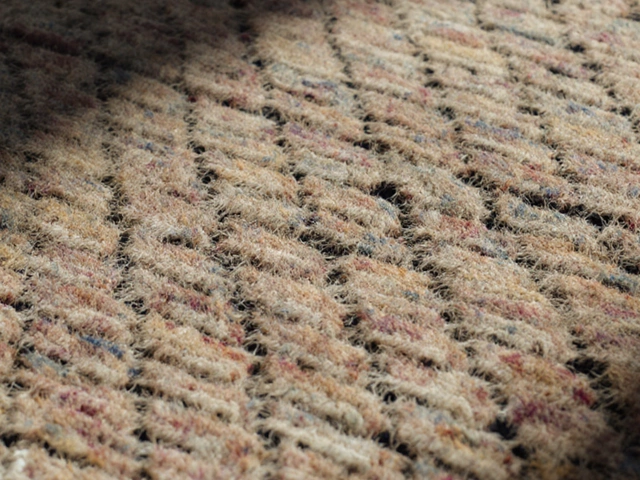In home decor, the color grey is often considered one of the most versatile and timeless choices. It's like that reliable friend who can seamlessly fit into any setting. Yet, when it comes to selecting the right curtains to pair with a grey sofa, the multitude of options can be both exciting and overwhelming. Whether you aim to create a serene and cohesive space or you're seeking bold contrasts, you have a myriad of choices before you.
Exploring different curtain colors can drastically change the ambiance of a room. The key lies in understanding how various shades and fabrics work in tandem with a grey base. From neutral palettes that whisper elegance to vibrant hues that offer a dramatic flair, the choices are endless. And let's not forget the intricate play of patterns and textures that can bring depth and character.
While selecting your curtains, it's also crucial to consider the lighting in your room, as natural and artificial light can alter the appearance of colors. Not to mention, there are practical aspects such as fabric durability and maintenance to keep in mind. Let's dive into these fascinating facets of interior design and discover how you can adeptly choose curtain colors that perfectly complement your grey sofa.
- Understanding the Versatility of Grey
- Neutral Palettes for a Cohesive Look
- Adding a Pop of Color for Visual Interest
- Playing with Patterns and Textures
- Lighting Considerations for Curtain Choices
- Tips for Mixing and Matching Decor
Understanding the Versatility of Grey
Grey, often embraced as a timeless shade, carries the unique ability to adapt to countless styles and moods. It's the chameleon of the color spectrum, harmonizing beautifully with almost any hue, whether bold or subdued. This adaptability makes a grey sofa an ideal staple for any living room, setting the stage for endless curtain color possibilities. It's a shade that can evoke tranquility or sophistication, depending on what you pair it with. Designers frequently commend its neutrality in establishing a balanced canvas that encourages creativity and personalization.
Consider the cool undertones of a lighter grey, reminiscent of a misty morning or gentle rain clouds. Pairing this with a similar palette can conjure an airy, peaceful atmosphere. On the other hand, deeper greys, akin to charcoal or slate, can elicit a more dramatic, elegant vibe, especially when contrasted with vibrant curtains. As esteemed designer Robert Allen once remarked, "Grey is the perfect shade for those who appreciate the subtle impact of design."
"The strength of grey lies in its neutrality, allowing for dynamic pairings and versatile designs." - Robert Allen
The beauty of grey doesn't just stop at its color compatibility. It tells its own story through textures. Imagine a plush, cushy sofa providing warmth and comfort, becoming the heart of a living space. Pair this with sleek, minimalist frame styles or classic, tufted designs to match specific tastes. Using grey can elevate the simplicity of modern homes, bringing out elegance without feeling overpowering. Interestingly, a survey by the Paint Quality Institute indicated that 52% of designers chose grey as their preferred neutral when creating sophisticated and relaxing spaces.
Now, delve into the allure of grey with your choice of curtains. This hue offers almost infinite opportunities to play with fabric and shades, anchoring a room's aesthetic while highlighting creativity. Whether the aim is to continue the grey theme's serenity with soft, pastel curtains or add spice with fiery reds, the possibilities are as vast as one's imagination. The role of grey here is unifying, effortlessly guiding different colors into harmony, forming a coherent and pleasing environment.
Neutral Palettes for a Cohesive Look
When decorating a room with a grey sofa, leaning into a neutral palette can create a serene and cohesive atmosphere. Neutral tones have a calming effect, bringing a sense of peace and tranquility to your living space. They allow the furniture to feel like an integrated part of the room, rather than a standout piece. Think creams, beiges, soft whites, and various shades of grey. These colors harmonize well with a grey sofa, enhancing the overall aesthetic without overpowering it. Here's a pro tip: choose curtains that are a few shades lighter or darker than your sofa to create depth while maintaining a monochromatic scheme.
A fascinating aspect of neutral tones is their ability to make a space feel both elegant and expansive. The light and tonal shades, combined with a grey sofa, can make a room appear larger than it is, which is especially beneficial in small apartments or rooms with limited natural light. Make sure to opt for curtain fabrics that reflect the light, like linen or silk blends, to contribute to this airy feel.
Curtain colors in the neutral category can also subtly highlight architectural details in your home. If you have crown molding or wainscoting, choosing a curtain color that complements these features can subtly draw the eye around the room, tying everything together. It's like crafting a whisper-soft design story where every element speaks to the other. According to interior designer Nate Berkus, "Your home should tell the story of who you are, and be a collection of what you love."
For those wary of a completely neutral space being too bland, consider incorporating varied textures to add interest. Thick, woven curtains or ones with embroidery can break up the monotony of flat colors. Also, mixing materials, such as combining sheer curtain panels with thicker drapes, can bring dynamism to the space while still relying on a neutral palette.
Sometimes, the simplest choices deliver the best results. Embrace the understated beauty of neutral colors, and you may find your grey sofa settling into a harmonious balance with its surrounds. It's a case where less truly becomes more, allowing each piece to shine in its own quiet way.
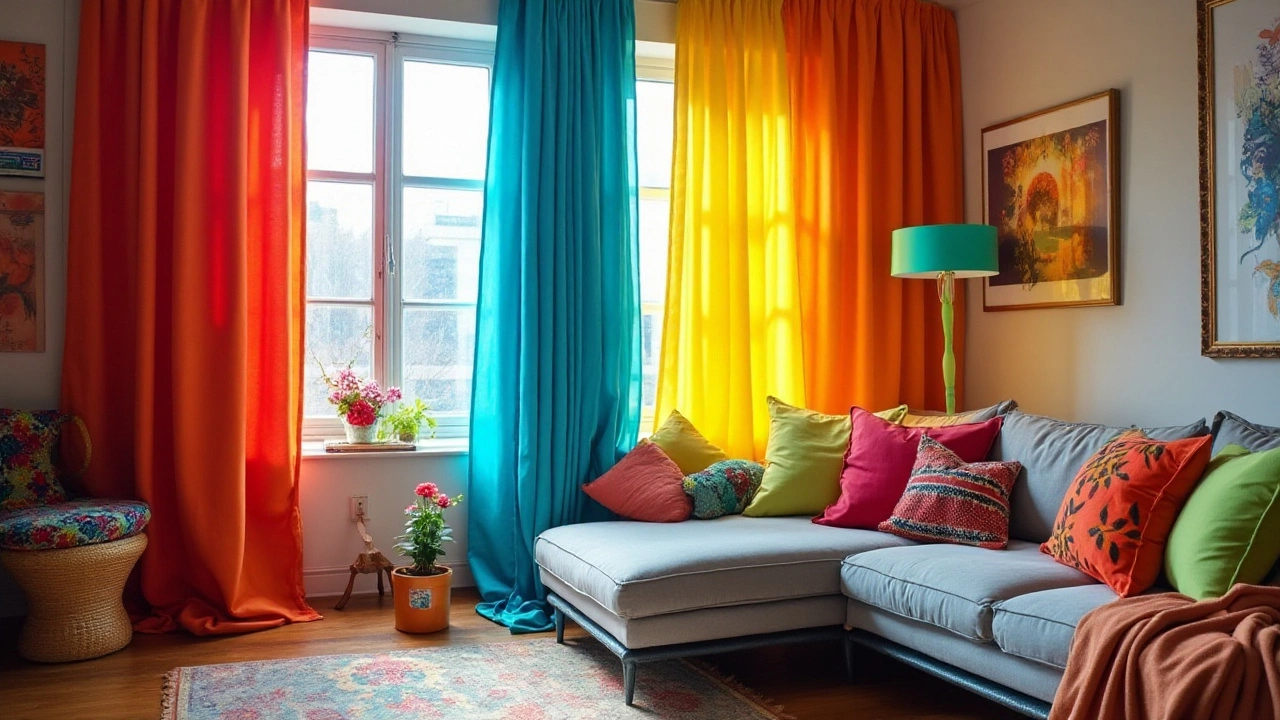
Adding a Pop of Color for Visual Interest
Incorporating a splash of color through your curtains can transform a subtle grey sofa into the star of your living room. This method introduces vibrancy and can either complement or contrast your existing decor. Imagine a bold, mustard-yellow curtain gracefully draping against a cool, grey backdrop. It's an instant eye-catcher and can imbue the space with energy, warmth, and style. With so many colors available, it’s essential to understand the effect each shade can have on both the room's mood and your sofa. A standout color can divert attention towards beautiful elements of the room or create a focal point that frames your beautiful furniture.
When deciding on a striking curtain color, consider how the hue plays with the light that enters your room at different times of the day. Colors like teal or deep burgundy can absorb light, lending a cozy and intimate feel to the space. On the other hand, bright tones like coral or turquoise can reflect light, making the room feel airy and expansive. This interplay of light and color can dramatically influence the perception of your room's size and ambiance. Expert designers often emphasize the importance of testing fabric samples in various lighting conditions to genuinely understand their interaction with your existing decor.
"Color is the backbone of mood and intention in a space," shares interior designer Sheila Bridges.
"Choosing the right color for your curtains can define the whole vibe of your area and either subtly or dramatically transform your environment."These insights remind us how significant a role curtain colors play in setting the tone of your home, beyond just aesthetic appeal.
For those willing to experiment, complementary colors on the color wheel can be an excellent guide. Pairing a grey sofa with curtains in shades like orange or rose can create a visually dynamic duo that embraces both contrast and harmony. If neutral spaces feel too safe, these bolder curtain colors can breathe life into a room, showcasing the sofa as well as enhancing other room features. Some may opt for patterned curtains that incorporate several colors, including the room's primary accent hue, knitting together various elements of your space.
Before finalizing your choice of curtains, think about the other accessories or focal points within the room. Adding cushions or throws in similar vibrant colors can echo your color choice, creating a sense of unity. This technique allows you to change the dynamics of the room without a complete overhaul, offering a versatile approach to evolving interior style preferences. In terms of fabric, options like silk or velvet can offer a luxurious finish, amplifying the drama and presence of your curtain colors.
Playing with Patterns and Textures
When it comes to creating a dynamic and visually appealing living room, patterns and textures play an enormously crucial role. They are like the spice cabinet of interior design, bringing layers of character and interest to a space. For many, a grey sofa serves as a neutral backdrop, inviting the opportunity to experiment with bold curtain patterns without overwhelming the room. Imagine adding a pair of striped curtains; their linear design can introduce a modern flair and subtly elongate the height of your windows, creating an illusion of bigger space.
One well-loved pattern that pairs beautifully with grey is floral. Large blooms in earthy tones or soft pastels can soften the stark simplicity of a grey sofa, adding warmth and a sense of coziness. This combination works particularly well in vintage or cottagecore-inspired homes. Not only do these patterns add a focal point to the room, but they also allow you to reflect your personality through your decor choices. For example, if you have a daring side, a geometric pattern could add a touch of modern sophistication.
Textures are another tool to shape the atmosphere of a room. They can add depth and tactile intrigue to your decor, enticing people to not just see the room, but also feel it with their senses. Velvet curtains, for instance, bring an opulent touch and can create a lush ambiance on cozy winter nights. Alternatively, linen offers a casual and relaxed look that breathes an air of simplicity and elegance, perfect for the summer months.
In the world of interior design, there’s always something new to learn and try. As Cynthia Rowley, the esteemed fashion designer, once said,
"The best things in life are often achieved through taking risks."So, go ahead and experiment with patterns and textures; there just might be a combination waiting to be discovered that speaks uniquely to your style.
Want to be extra creative? Try mixing patterns! To do this effectively, start by keeping a consistent color palette. This ensures that your patterns do not clash, but rather complement each other. Mixing stripes with florals might seem daunting, but when executed thoughtfully, it can showcase a level of design acumen that stands out. Always remember: the best decor styles are those that reflect who you are and the atmosphere you wish to create in your home.
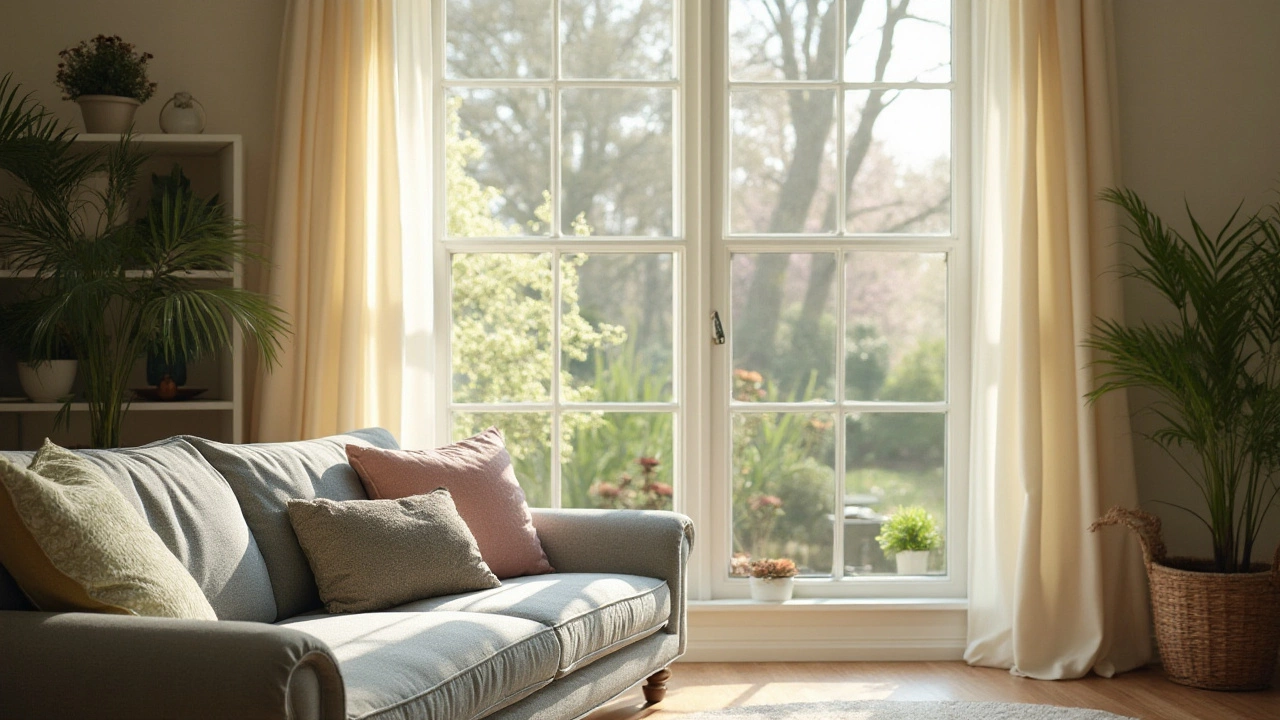
Lighting Considerations for Curtain Choices
When it comes to choosing curtains that complement a grey sofa, understanding how lighting impacts color perception is crucial. Natural light can dramatically alter how colors are seen, sometimes making them appear warmer or cooler. In the hours of bright daylight, for instance, a blue curtain might look vibrant yet soothing. As dusk settles, the same blue can take on a more muted or even grayish tone. This interplay is why it’s important to observe potential curtain colors in both artificial and natural light.
Artificial lighting also plays a significant role. The type of bulbs used, whether warm or cool, can shift the mood set by your curtain colors. LED lights might enhance brighter shades, making them appear more vivid. On the other hand, incandescent bulbs can add a warmth that might make certain colors feel cozy yet slightly different than their natural state. It’s wise to test curtain samples in your home using both types of lighting to truly get a sense of how they will look over the course of a day.
Interior design experts often remind us of the importance of directionality in natural light. Rooms that face north tend to have cooler light, making them ideal for warmer curtain colors if you wish to balance out the ambiance. Conversely, south-facing rooms get plenty of sunlight, and cooler hues might help maintain a fresh feel. "Good lighting is to interiors what music is to a party," as renowned designer Martyn Lawrence Bullard puts it.
"It's crucial to get it right, not just for aesthetics, but for how a space makes you feel," he adds.
In terms of strategic placement, sheer curtains are an excellent way to filter light gently, softening harsh sunlight while maintaining a warm glow. You might consider layering curtains to add flexibility. Having a sheer set underneath darker drapes allows you to control the amount of light entering the room and can emphasize the color dynamics on your grey sofa. When considering color and fabric, opt for materials that don’t bleach out or fade quickly under direct sunlight. Fabrics like block-out cotton or UV-treated materials are sturdy and provide additional benefits.
If you're keen on experimenting with color combinations under diverse lighting, consider creating a small swatch board. Place bits of your chosen curtain fabrics alongside your grey sofa fabric under varied lighting conditions at different times of the day. A simple practice like this can legitimately save you from any future disappointments regarding color mismatches. Take it as an artist’s canvas, where every stroke and shade influences the masterpiece. Awareness of how your choices behave under diverse lighting is an art and science combined in the sweetest harmony of home decor.
Tips for Mixing and Matching Decor
Creating a living space that feels both harmonious and dynamic involves mastering the art of mixing and matching decor. It's about creating a balance between different elements while making sure your personality shines through. One of the key aspects is understanding the scale and proportion of your decor items. When you have a main focal point like a grey sofa, it's essential to choose other pieces that complement rather than compete with it. Consider the size of your sofa and room, ensuring that any additional furniture or decor elements are proportionally aligned. Oversized coffee tables or minuscule side chairs might disrupt the balance, making the room feel awkward rather than inviting.
Color coordination can also have a significant impact, influencing the mood and aesthetic of the room. When combining various colors, think of a primary, secondary, and accent color to create a coherent palette. The curtain colors you choose can either blend with your grey sofa as part of a neutral scheme or stand out as a vibrant accent. For a cohesive look, pick up the curtain hues in smaller decor items like cushions, artwork, or vases. If you'd like to explore bolder combinations, rich mustard or teal curtains can invigorate a space, especially with metallic or wooden accents that introduce warmth and texture.
"Design is not just what it looks like, design is how it works." — Steve JobsPatterns and textures often get overlooked, but they are powerful tools in creating depth and interest. A textured rug or patterned throw pillows can add layers, offering both visual appeal and tactile contrast. Think about contrasting textures—perhaps a sleek, polished table paired with a soft, plush rug underfoot. This consideration applies to curtains as well; a patterned curtain can become a statement piece in a simple room, while textured curtains, such as velvet, can bring a sense of luxury and comfort.
Lighting plays a significant role in how colors and textures are perceived, influencing mood and functionality. Natural light can enhance colors, often making them look more vibrant, while artificial light can affect the warmth and tone, sometimes muting colors. To get the best of both worlds, try layering lighting, using a combination of ceiling fixtures, floor lamps, and table lamps. This approach not only offers versatility but also allows you to highlight various decor elements at different times of the day.
Finally, don't be afraid to inject a bit of your own style. Personal touches make a space uniquely yours. Whether it’s a travel souvenir or a family heirloom, these pieces tell a story. They create a compelling contrast between new design elements and cherished belongings. Mixing new and old pieces brings character and authenticity to your home, making it a place where past and present coexist beautifully. In the end, it's these thoughtful decisions that master the art of mixing and matching, creating a room that is not only visually appealing but also a reflection of who you are.

